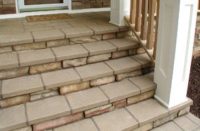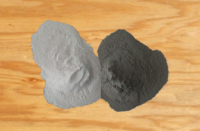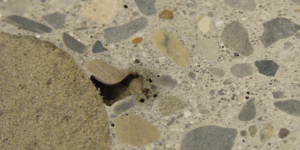The issue of blisters and pin holes occurring on the surface of cast-in-place concrete and resin-based coatings and sealers is well documented, but surprisingly very little is published regarding the same issues in decorative overlays.
While the root cause is the same across product markets, decorative overlays tend to be more susceptible to these types of problems. The nature of the overlay materials combined with common application methods tend to increase their frequency. If you experience these surface imperfections, a few minor adjustments in how the products are mixed and applied can go a long way in reducing them.
Problematic gas
For clarification, blisters and pin holes in a decorative overlay are all caused by some type of off-gassing. These defects shouldn’t be confused with spalling, scaling and pop-outs, which are also surface defects but are caused by something else.
Off-gassing, also known as outgassing, is defined as the release of a gas that was dissolved, trapped, frozen or absorbed in some material. Gas can be air, water vapor or a byproduct of a chemical reaction in the overlay.
Some form of gas is always present when an overlay is mixed and applied. It comes from a combination of entrapment from mixing, reaction of the overlay ingredients and gas in the substrate. In all overlay applications, the gas must escape, primarily through the surface.
Depending on the overlay surface’s plastic state:
- The gas either escapes and the material surface self-heals,
- The gas escapes but the material is too stiff to self-heal which results in pin holes, or
- The gas doesn’t escape, accumulates near the surface because the material is really stiff and results in a subsurface blister.
The mechanism for why blisters and pin holes occurs is pretty straight forward, but how to avoid them might not be. Here are some common methods and techniques to reduce or eliminate blisters and pin holes in decorative overlays.
Use a primer
Priming does two things. It helps promote adhesion between the substrate and overlay and it helps displace and stop gas movement out of the substrate. Primers range from low-solids latex glue to high-solids epoxy coatings. I’ve become a proponent of the higher-solids systems since they do a better job of sealing the substrate from gas movement.
As a side note, if you find yourself on a job without a primer and the show must go on, using a light mist of water as a primer — no puddles — is better than applying an overlay to a dry surface. A lack of a primer or poor primer application is the leading cause of pin holes in thin-section overlays. Always refer to the manufacturer’s guidelines for the recommended primer.
Mix it right
Using the wrong mixer or a poor mixing technique is often missed as a source of trapped gas. The right mixer for the job is important, especially when dealing with time-sensitive fast-setting mixes.
A slow RPM or low-torque mixer means longer mix times, which allows more air to be pulled into the material. Equally important is the mixing blade. Double-helix blades that pull material from the bottom up are the best for any cement-based overlay.
Avoid moving the blade up and down during mixing as this pulls more air into the material. Bottom line: Whatever goes into the mix (water and air) needs to come out. A short rest period after mixing and before pouring the product can also help de-gas the material.
Temperature difference matters
A cold substrate compared to the ambient air temperature can lead to a false set. The surface sets before the bottom, trapping gas in the material which leads to blisters.
This is an issue in shoulder seasons where there are major temperature swings or when dealing with shadows on exterior projects any time of the year. Shadow management on a project is a real thing!
Keep surface open
If an overlay’s surface tightens up quickly, blisters can form. Warm and windy conditions, as well as early finishing, are the common culprits.
The surface needs to remain open to allow for off-gassing. In certain cases this may require applying less square footage to offset the increased wait time. In my experience, this is the leading cause of blisters in trowel-applied overlay systems.
Material reaction
The least understood method for controlling blisters and pin holes may be in the material itself. Every product uses different raw materials that affects its chemistry.
The system’s polymers may react to the alkalinity and mineral content of your region’s mix water resulting in possible side reactions and excess off-gassing. If you feel you have control over the process and are still getting excess blisters and pin holes, it may be time to look at the water source or evaluating a new material.
Control the outcome
Off-gassing is a natural process that occurs in all cement-based overlays. By understanding the cause it becomes easier to control the outcome.
Blisters and pin holes may not be structural issues, but in the world of decorative concrete where aesthetics is often as important, they can ruin what otherwise would be a great job.















